display SAAB 9-3 2003 Owners Manual
[x] Cancel search | Manufacturer: SAAB, Model Year: 2003, Model line: 9-3, Model: SAAB 9-3 2003Pages: 256, PDF Size: 21.66 MB
Page 3 of 256
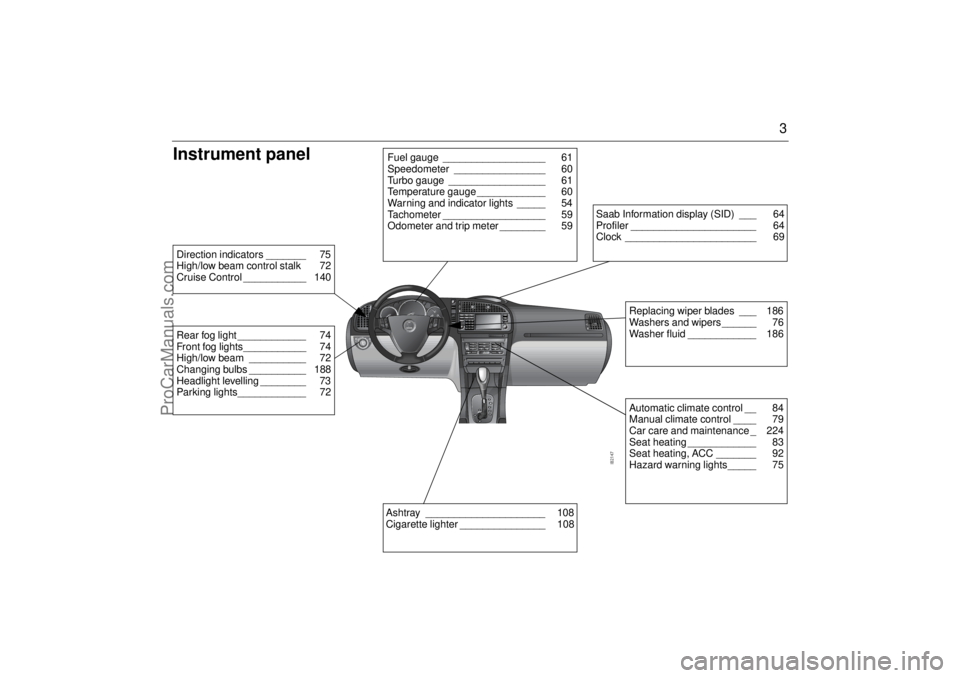
3
Instrument panelRear fog light ____________ 74
Front fog lights___________ 74
High/low beam __________ 72
Changing bulbs __________ 188
Headlight levelling ________ 73
Parking lights____________ 72Direction indicators _______ 75
High/low beam control stalk 72
Cruise Control ___________ 140
Fuel gauge __________________ 61
Speedometer ________________ 60
Turbo gauge _________________ 61
Temperature gauge ____________ 60
Warning and indicator lights _____ 54
Tachometer __________________ 59
Odometer and trip meter ________ 59Ashtray _____________________ 108
Cigarette lighter _______________ 108
Saab Information display (SID) ___ 64
Profiler ______________________ 64
Clock _______________________ 69
Replacing wiper blades ___ 186
Washers and wipers ______ 76
Washer fluid ____________ 186Automatic climate control __ 84
Manual climate control ____ 79
Car care and maintenance _ 224
Seat heating ____________ 83
Seat heating, ACC _______ 92
Hazard warning lights_____ 75
ProCarManuals.com
Page 11 of 256
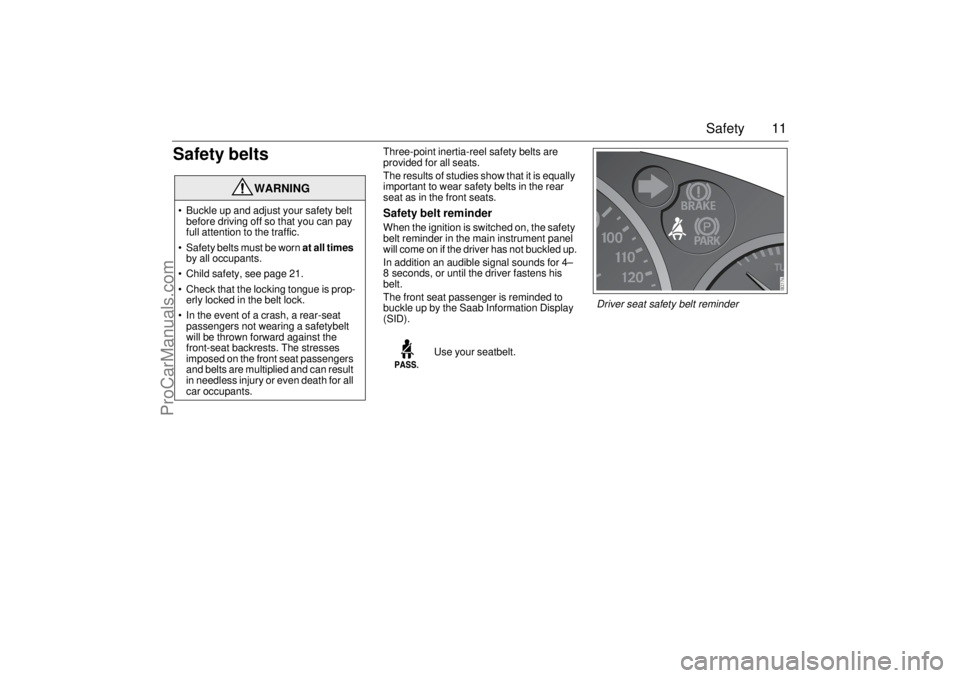
11 Safety
Safety belts
Three-point inertia-reel safety belts are
provided for all seats.
The results of studies show that it is equally
important to wear safety belts in the rear
seat as in the front seats.Safety belt reminderWhen the ignition is switched on, the safety
belt reminder in the main instrument panel
will come on if the driver has not buckled up.
In addition an audible signal sounds for 4–
8 seconds, or until the driver fastens his
belt.
The front seat passenger is reminded to
buckle up by the Saab Information Display
(SID).
WARNING
Buckle up and adjust your safety belt
before driving off so that you can pay
full attention to the traffic.
Safety belts must be worn at all times
by all occupants.
Child safety, see page 21.
Check that the locking tongue is prop-
erly locked in the belt lock.
In the event of a crash, a rear-seat
passengers not wearing a safetybelt
will be thrown forward against the
front-seat backrests. The stresses
imposed on the front seat passengers
and belts are multiplied and can result
in needless injury or even death for all
car occupants.
Use your seatbelt.
Driver seat safety belt reminder
ProCarManuals.com
Page 27 of 256

27 Safety
The driver and passenger front airbags are
triggered by violent front-end crashs. They
are not activated by minor front-end
impacts, if the car overturns or by rear- and
side-impacts.There are two impact sensors on the front
bumper, under the lacquered shell. Very
soon after the moment of impact, these
register that the car is involved in a crash.
Using this information and data from the
central sensor in the control module, the
control module determines whether or not to
inflate the airbags. The control module also
controls whether other components of the
airbag system are to be deployed: safety
belt pretensioners, side airbags and inflat-
able curtains.
Which airbag system components are
deployed depends on a number of factors,
such as the force of the crash and the angle
of impact.If the airbag system registers forces equiv-
alent to a high-speed crash (airbags inflated
to Stage II), the inflatable curtains will also
be activated (see page 32).
If the airbags are deployed, the positive
terminal of the battery will be disconnected,
See page 184.
If a fault arises in the airbag system during
a journey, the airbag warning lamp on the
main instrument panel will come on and the
Saab Information Display (SID) will display:
The car is equipped as standard with
a passenger airbag.Airbag malfunction.
Contact Saab dealer.
Both front airbags inflated
Inflated airbag (driver’s side).
Inflation and deflation of airbag takes
approx. 0.1 s
ProCarManuals.com
Page 38 of 256
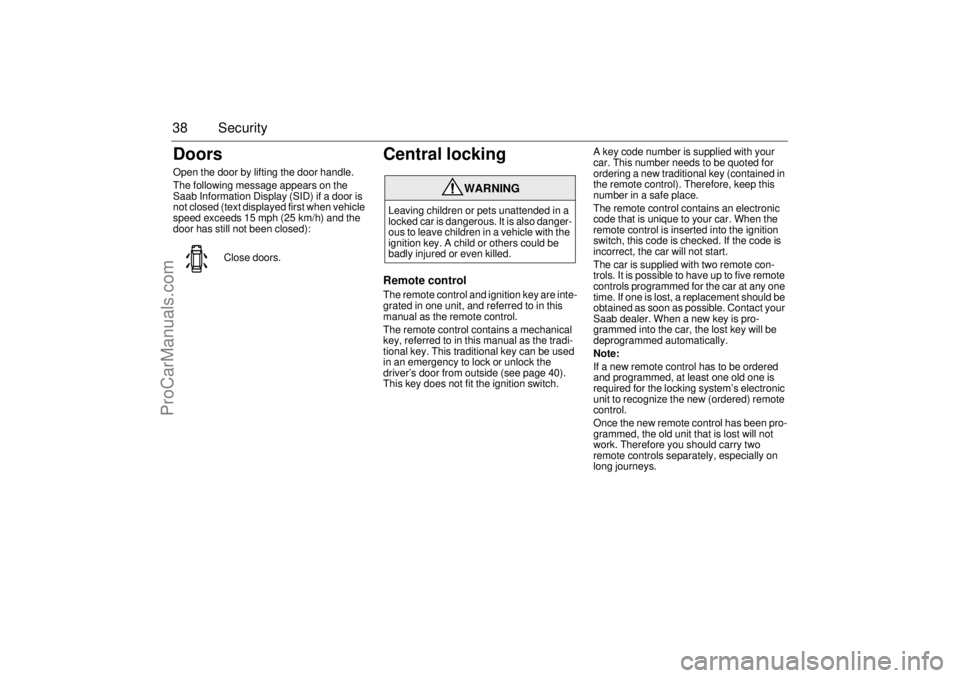
38 SecurityDoorsOpen the door by lifting the door handle.
The following message appears on the
Saab Information Display (SID) if a door is
not closed (text displayed first when vehicle
speed exceeds 15 mph (25 km/h) and the
door has still not been closed):
Central lockingRemote controlThe remote control and ignition key are inte-
grated in one unit, and referred to in this
manual as the remote control.
The remote control contains a mechanical
key, referred to in this manual as the tradi-
tional key. This traditional key can be used
in an emergency to lock or unlock the
driver’s door from outside (see page 40).
This key does not fit the ignition switch.A key code number is supplied with your
car. This number needs to be quoted for
ordering a new traditional key (contained in
the remote control). Therefore, keep this
number in a safe place.
The remote control contains an electronic
code that is unique to your car. When the
remote control is inserted into the ignition
switch, this code is checked. If the code is
incorrect, the car will not start.
The car is supplied with two remote con-
trols. It is possible to have up to five remote
controls programmed for the car at any one
time. If one is lost, a replacement should be
obtained as soon as possible. Contact your
Saab dealer. When a new key is pro-
grammed into the car, the lost key will be
deprogrammed automatically.
Note:
If a new remote control has to be ordered
and programmed, at least one old one is
required for the locking system’s electronic
unit to recognize the new (ordered) remote
control.
Once the new remote control has been pro-
grammed, the old unit that is lost will not
work. Therefore you should carry two
remote controls separately, especially on
long journeys. Close doors.
WARNING
Leaving children or pets unattended in a
locked car is dangerous. It is also danger-
ous to leave children in a vehicle with the
ignition key. A child or others could be
badly injured or even killed.
ProCarManuals.com
Page 40 of 256
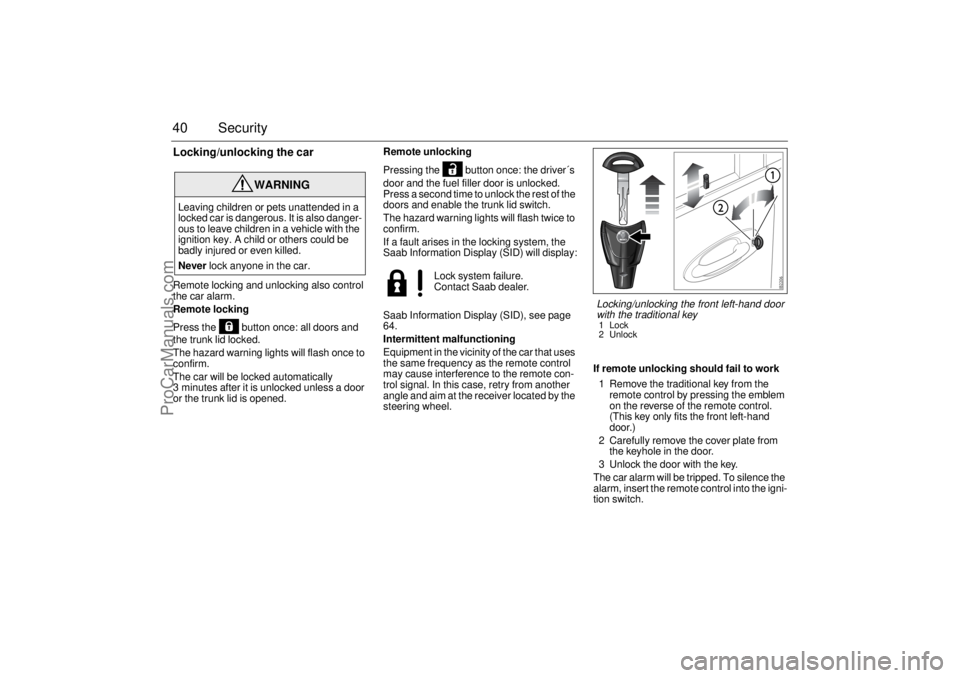
40 SecurityLocking/unlocking the carRemote locking and unlocking also control
the car alarm.
Remote locking
Press the button once: all doors and
the trunk lid locked.
The hazard warning lights will flash once to
confirm.
The car will be locked automatically
3 minutes after it is unlocked unless a door
or the trunk lid is opened.Remote unlocking
Pressing the button once: the driver´s
door and the fuel filler door is unlocked.
Press a second time to unlock the rest of the
doors and enable the trunk lid switch.
The hazard warning lights will flash twice to
confirm.
If a fault arises in the locking system, the
Saab Information Display (SID) will display:
Saab Information Display (SID), see page
64.
Intermittent malfunctioning
Equipment in the vicinity of the car that uses
the same frequency as the remote control
may cause interference to the remote con-
trol signal. In this case, retry from another
angle and aim at the receiver located by the
steering wheel.If remote unlocking should fail to work
1 Remove the traditional key from the
remote control by pressing the emblem
on the reverse of the remote control.
(This key only fits the front left-hand
door.)
2 Carefully remove the cover plate from
the keyhole in the door.
3 Unlock the door with the key.
The car alarm will be tripped. To silence the
alarm, insert the remote control into the igni-
tion switch.
WARNING
Leaving children or pets unattended in a
locked car is dangerous. It is also danger-
ous to leave children in a vehicle with the
ignition key. A child or others could be
badly injured or even killed.
Never lock anyone in the car.
Lock system failure.
Contact Saab dealer.
Locking/unlocking the front left-hand door
with the traditional key1 Lock
2 Unlock
ProCarManuals.com
Page 43 of 256
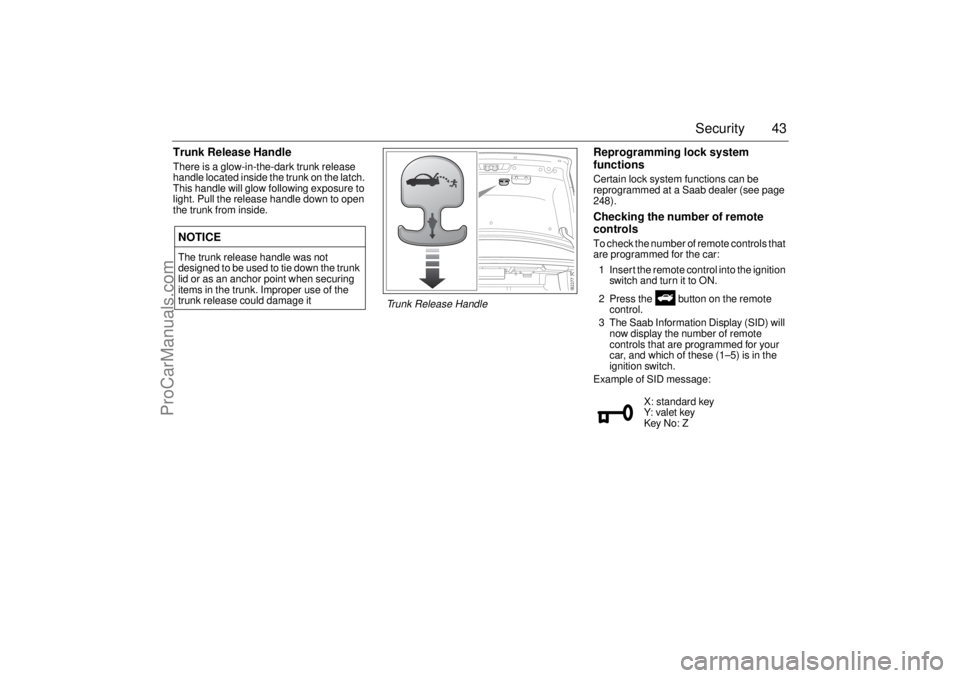
43 Security
Trunk Release HandleThere is a glow-in-the-dark trunk release
handle located inside the trunk on the latch.
This handle will glow following exposure to
light. Pull the release handle down to open
the trunk from inside.
Reprogramming lock system
functionsCertain lock system functions can be
reprogrammed at a Saab dealer (see page
248).Checking the number of remote
controlsTo check the number of remote controls that
are programmed for the car:
1 Insert the remote control into the ignition
switch and turn it to ON.
2 Press the button on the remote
control.
3 The Saab Information Display (SID) will
now display the number of remote
controls that are programmed for your
car, and which of these (1–5) is in the
ignition switch.
Example of SID message:
NOTICEThe trunk release handle was not
designed to be used to tie down the trunk
lid or as an anchor point when securing
items in the trunk. Improper use of the
trunk release could damage it
X: standard key
Y: valet key
Key No: Z
Trunk Release Handle
ProCarManuals.com
Page 44 of 256
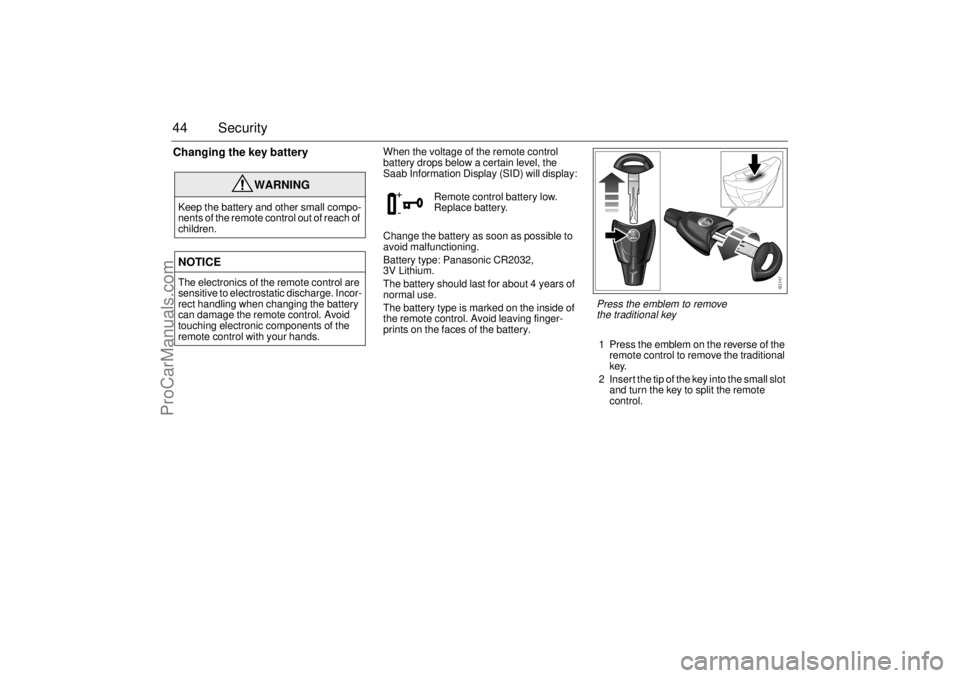
44 SecurityChanging the key battery
When the voltage of the remote control
battery drops below a certain level, the
Saab Information Display (SID) will display:
Change the battery as soon as possible to
avoid malfunctioning.
Battery type: Panasonic CR2032,
3V Lithium.
The battery should last for about 4 years of
normal use.
The battery type is marked on the inside of
the remote control. Avoid leaving finger-
prints on the faces of the battery.
1 Press the emblem on the reverse of the
remote control to remove the traditional
key.
2 Insert the tip of the key into the small slot
and turn the key to split the remote
control.
WARNING
Keep the battery and other small compo-
nents of the remote control out of reach of
children.NOTICEThe electronics of the remote control are
sensitive to electrostatic discharge. Incor-
rect handling when changing the battery
can damage the remote control. Avoid
touching electronic components of the
remote control with your hands.
Remote control battery low.
Replace battery.
Press the emblem to remove
the traditional key
ProCarManuals.com
Page 45 of 256
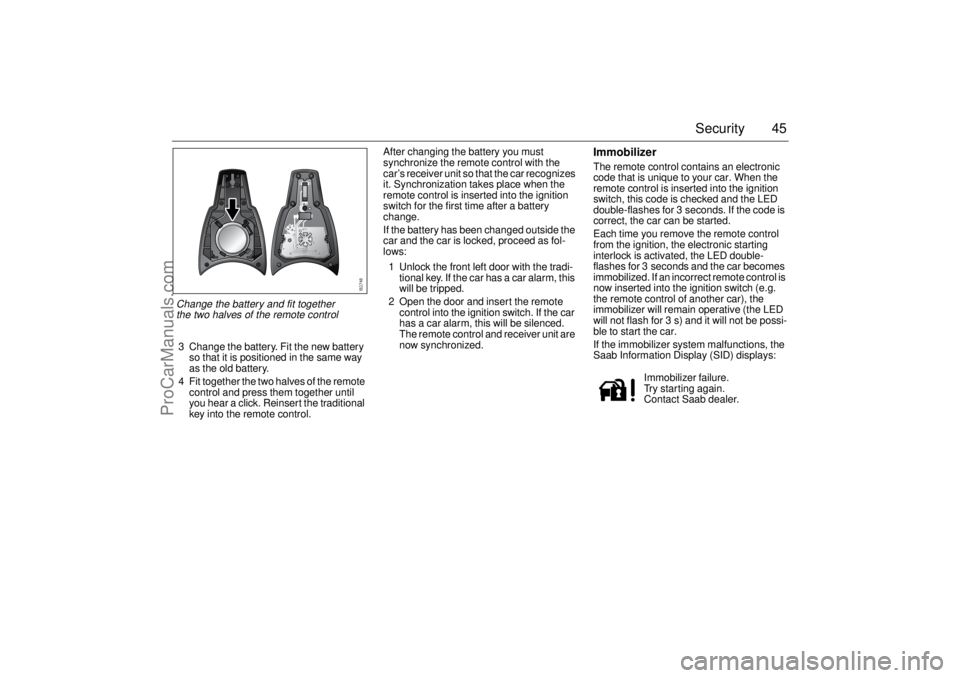
45 Security
3 Change the battery. Fit the new battery
so that it is positioned in the same way
as the old battery.
4 Fit together the two halves of the remote
control and press them together until
you hear a click. Reinsert the traditional
key into the remote control.After changing the battery you must
synchronize the remote control with the
car’s receiver unit so that the car recognizes
it. Synchronization takes place when the
remote control is inserted into the ignition
switch for the first time after a battery
change.
If the battery has been changed outside the
car and the car is locked, proceed as fol-
lows:
1 Unlock the front left door with the tradi-
tional key. If the car has a car alarm, this
will be tripped.
2 Open the door and insert the remote
control into the ignition switch. If the car
has a car alarm, this will be silenced.
The remote control and receiver unit are
now synchronized.
ImmobilizerThe remote control contains an electronic
code that is unique to your car. When the
remote control is inserted into the ignition
switch, this code is checked and the LED
double-flashes for 3 seconds. If the code is
correct, the car can be started.
Each time you remove the remote control
from the ignition, the electronic starting
interlock is activated, the LED double-
flashes for 3 seconds and the car becomes
immobilized. If an incorrect remote control is
now inserted into the ignition switch (e.g.
the remote control of another car), the
immobilizer will remain operative (the LED
will not flash for 3 s) and it will not be possi-
ble to start the car.
If the immobilizer system malfunctions, the
Saab Information Display (SID) displays:
Immobilizer failure.
Try starting again.
Contact Saab dealer.
Change the battery and fit together
the two halves of the remote control
ProCarManuals.com
Page 47 of 256
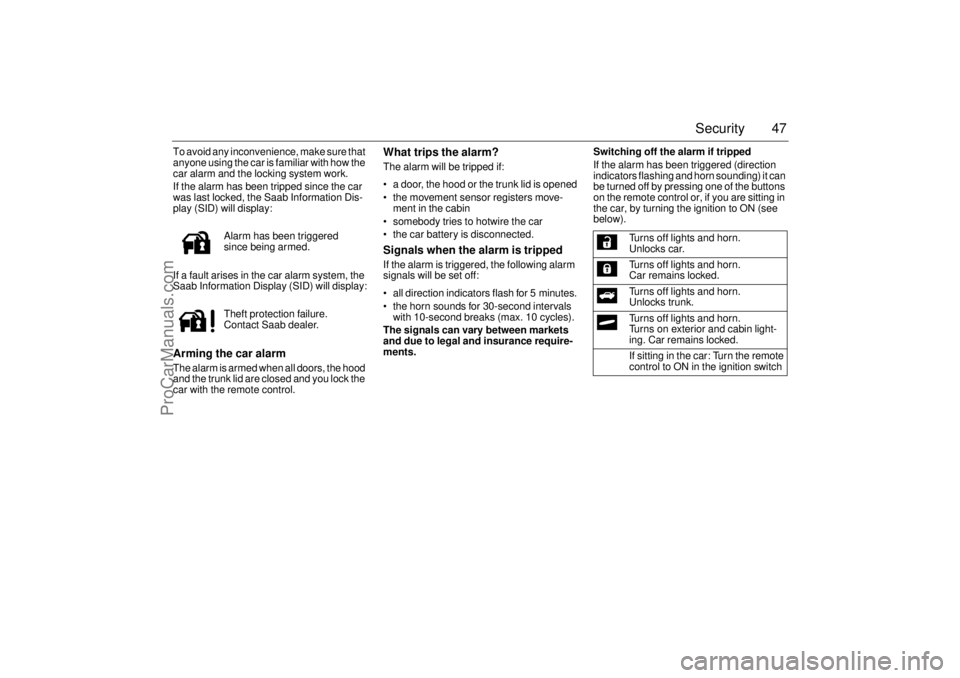
47 Security
To avoid any inconvenience, make sure that
anyone using the car is familiar with how the
car alarm and the locking system work.
If the alarm has been tripped since the car
was last locked, the Saab Information Dis-
play (SID) will display:
If a fault arises in the car alarm system, the
Saab Information Display (SID) will display:Arming the car alarmThe alarm is armed when all doors, the hood
and the trunk lid are closed and you lock the
car with the remote control.
What trips the alarm?The alarm will be tripped if:
a door, the hood or the trunk lid is opened
the movement sensor registers move-
ment in the cabin
somebody tries to hotwire the car
the car battery is disconnected.Signals when the alarm is trippedIf the alarm is triggered, the following alarm
signals will be set off:
all direction indicators flash for 5 minutes.
the horn sounds for 30-second intervals
with 10-second breaks (max. 10 cycles).
The signals can vary between markets
and due to legal and insurance require-
ments.Switching off the alarm if tripped
If the alarm has been triggered (direction
indicators flashing and horn sounding) it can
be turned off by pressing one of the buttons
on the remote control or, if you are sitting in
the car, by turning the ignition to ON (see
below).
Alarm has been triggered
since being armed.
Theft protection failure.
Contact Saab dealer.
Turns off lights and horn.
Unlocks car.
Turns off lights and horn.
Car remains locked.
Turns off lights and horn.
Unlocks trunk.
Turns off lights and horn.
Turns on exterior and cabin light-
ing. Car remains locked.
If sitting in the car: Turn the remote
control to ON in the ignition switch
ProCarManuals.com
Page 50 of 256

50 SecurityOverview of functionsLocking/arming Direction indicators flash once.
Unlocking/
disarmingHazard warning lights flash twice.
Unlocking/
disarming trunk
lidHazard warning lights flash three times.
Alarm triggered Direction indicators flash for 5 min.
The horn sounds for 30-second intervals with
10-second breaks (max. 10 cycles) or until you
press one of the remote control buttons or turn
the remote control ON in the ignition switch.
Movement
sensorThe movement sensor trips the alarm if it regis-
ters a movement in the cabin.
Remote control Normal range: 5–16 yds. (5–15 metres).
In favorable conditions the range can be signif-
icantly greater.
Remote control
batteryNormal life: approx. 4 years.
Change the battery when the SID displays:
Remote control battery low. Replace battery.
See Changing the key battery, page 44.
Car battery The alarm will trip if the battery is disconnected
when the alarm is armed.
Some car alarm functions and indications can be reprogrammed.
Contact a Saab dealer for details of the possibilities and refer to
page 248.
ProCarManuals.com